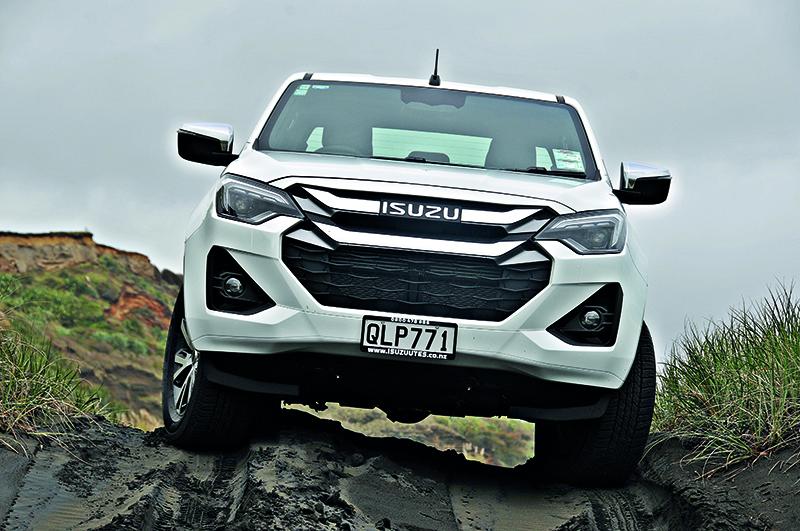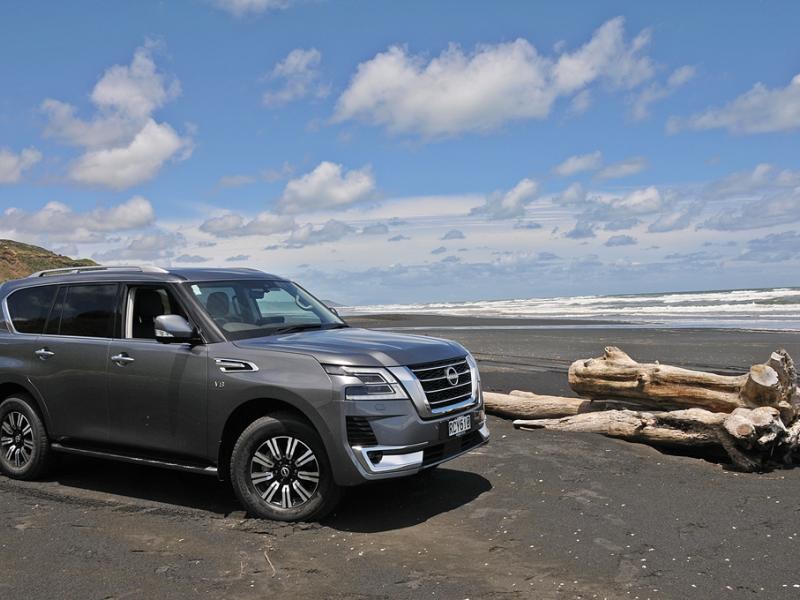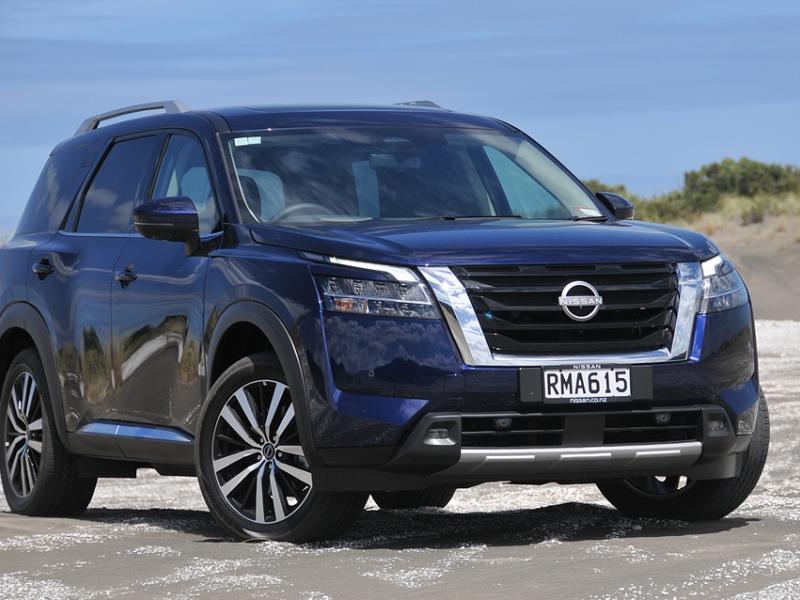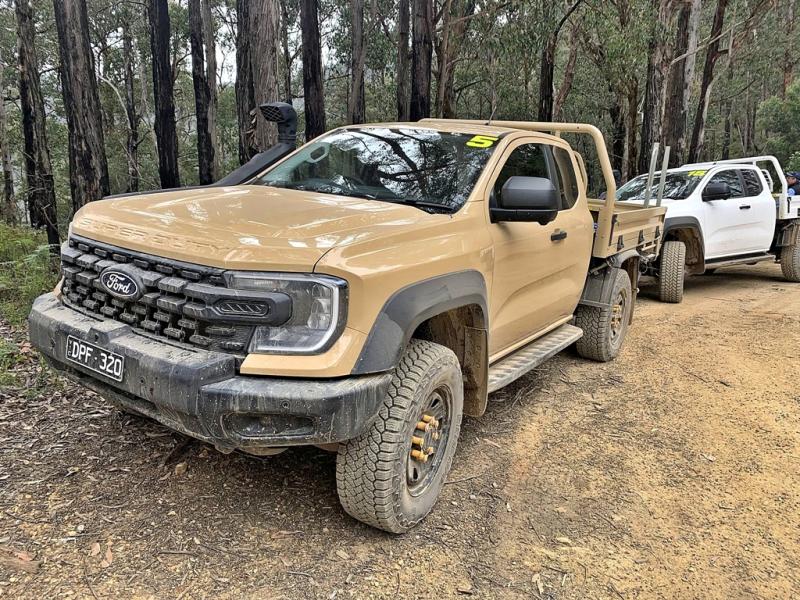It was rubbish weather. All week the sun shone, rain fell each night but the mornings were glorious. Come the weekend, the whole North Island is shrouded in miserable curtains of rain.
But that can be the best time to examine a 4WD double cab ute. After all, life isn’t all sunny days and rainbows, right?
It’s been a while since NZ4WD had a D-Max to drive. This one might well be the pick of the litter too.
It’s an LS, flash but not flashy, and based on the tough truck-style drivetrain that underpins the whole 2024 D-Max range.
In the midst of a dismal Auckland rain storm, we used the D-max to head out west to the Kumeu 4x4 expo, and it did us proud.
Sure, the strong torque profile of the engine meant it was easy to light up the rear wheels briefly at rain-blitzed roundabouts, but that’s down to driver ability too and was easy to control. Into the car park at the event – wet grass disappearing under rivulets of rain-water – and we had the throttle technique sorted. Old mate in a Jeep Wrangler ahead of us was having fun and had all four wheels spinning, we just cruised up behind him. He was crossed up, elbows flailing; we were cruising along just tickling the throttle in 2-hi.
So anyway, after the expo, we headed out to Muriwai. Perfect day for a beach run. Wet black sand, horizontal rain, the beach was deserted. The only other truck out there was another Isuzu – a family and dog out for a cruise in their 2019 MU-X.
We have had the earlier D-Max out here before, but a beach is a dynamic place – every day it’s different. The truck, though doesn’t disappoint. It’s still the no-nonsense hard worker it’s always been. Shifting into 4-hi is all that’s needed, leaving 4-lo and a rear diff lock in reserve if needed. Mostly, the sand below the high water mark is firm enough to drive on in RWD, but there are patches where it turns almost liquid that require 4WD, momentum and careful use of the throttle. There are always sand-washed rusty remnants of cars and occasionally 4WDs whose owners have learned this the hard way.
Isuzu has refreshed the D-Max exactly four years after the debut of the ‘gen 3’ range. In the process, it has reviewed and refined the model range available.
There are improvements to design, multimedia and safety. A new-look front end incorporates newly designed bumper, grille and headlights but remains squarely within the D-Max ‘family’.
The new look continues down each side with redesigned wheelarch flares. These are wide enough to keep sticks and stones from flicking up and ruining the paint-work unless the off-road environment turns a bit gnarly.
With Ford, Volkswagen and now Mitsubishi all launching new 4WD utes in the past couple of years, it’s a good time for Isuzu to freshen things up.
Inside, fiddly volume and radio tuning buttons have been replaced by two dials, which are much easier to locate on the move without distracting the driver.
A row of physical buttons across the base of the display give access to frequently used controls like air conditioning and the electronic control for the transfer case in under these, close to the driver for easy shifting.
To the left are more controls including hill descent control.
Cupholders are plentiful. In addition to the expected holders in the centre console, there are dash-mounted holders at left and right. These are set into the dash and deploy when pushed. Great for supping hot drinks while on the move – just watch out when climbing in and out. It’s easy to smack a knee up against the holder if it’s in use.
One small note: we did ‘lose’ the throttle pedal a couple of times in bouncy terrain (mainly the churned sand leading back up to the access track on Muriwai). The pedal has a diagonal cut across the right side of its lower edge, and we’d been using the lower part of the pedal in order to get more modulation in the variable going. Throttle foot ended up pushing air! It never happened on tarmac, where we used the whole surface of the throttle pedal. A bit of right foot retraining needed perhaps.
Rear seat passengers have air venting, a small cubby for bits and pieces, and a USB power outlet.
The LS and X-Terrain models have revised alloy wheel styles, our LS arriving with quite complex 18-inch alloys with bright-cut faces. The treatment of the taillights and tailgate have also been refreshed for 2024.
Powering all variants of the 2024 D-MAX is Isuzu’s 3.0-litre 4JJ3 engine featuring a variable geometry turbocharger (VGT). Peak torque is delivered at 2,000rpm – right where it’s needed. There’s a smaller 1.9-litre engine available overseas, but not here. Not sure there’d be a strong demand for a small engine here, the market entry point is a high output 2.0 turbodiesel (Mitsubishi Triton, Ford Ranger, VW Amarok) stepping up from there to a 3.0-litre inline four (Isuzu) and on to 3.0-litre turbodiesel V6 (Ranger, Amarok).
Mazda’s BT-50 stands alone, offering a 1.9-litre (110kW/350Nm) four-cylinder turbo-diesel alongside its mainstay Isuzu-built 3.0-litre four-cylinder turbo-diesel engine. The company is of course dropping the BT-50 from its New Zealand line-up. That leaves Isuzu with a unique place in the market thanks to the gruff muscle of its 3.0-litre engine.
A six-speed automatic transmission is standard across the entire 2024 D-MAX range as has been the case for the past four years.
Isuzu is one of the few brands that still offers a manual transmission: a six speed is available as a no-cost option on selected models.
Off-road capability is further bolstered by a new Rough Terrain Mode.
There’s a new infotainment system with a new graphic and user interface, increased processing speed and better usability. Wireless Apple CarPlay and Android Auto are standard across the range.
The 2024 D-MAX includes an updated suite of IDAS active safety functionality which uses a new ADAS stereo camera.
The rear-end collision warning was tested repeatedly when reversing down the driveway – Papakura locals use the street as a rat-run arterial and many of them do so at more than 50km/h, meaning exiting can be a risky business. The forward collision warning was tested on the run back from west Auckland in clouds of rain and road spray, and it’s a safety boon in rubbish weather. Sitting high up in a proper 4WD is always handy in Auckland traffic; the collision warning is an added weapon in the battle to get home unscathed.
Predictably, the next day dawned fine and warm, the storm gone from Auckland skies. Right then. Off again, this time to the Waiuku area.
The tarmac road leading to Waiuku Forest and the Waikato River is a narrow ribbon of tarmac laid across what was until recently a bog. In a couple of kilometres of road, it’s hardly got a stretch of 20 metres that qualify as straight and level. That means it’s a torture test for utes with leaf-sprung load-carrying rear ends. In some cases, that torture extends to the soft human bits in the cab.
The road does remind us that there’s a leaf sprung rear end in there, and that it would be smoother with a payload in the cargo bed, but it’s nowhere near some of the lesser lights of the category. Likewise, it’s well damped over corduroy corrugations on the forest roads. Big potholes do upset the direction of travel but would do so with any such ute.
Predictably, the sun is playing hide and seek by now, and disappears behind rain clouds as we reach the beach.
Turning to the west, we run along some narrow back roads to connect out to Karioitahi Beach. Though both Muriwai and Karioitahi are black sand west coast beaches, they are quite different. Karioitahi has wide areas of sloppy wet sand with hard-pack down close to the water line. This time we play safe with 4-lo, traction control off, keeping the rear diff lock as a last resort. It takes an aggressive accelerator foot to chew a path through the slop.
From there, we can use the hard-pack to go south along the beach a couple of km, crossing a couple of wee creeks to return along established tracks at the base of the Karioitahi cliffs. The D-Max handles it all with aplomb. Twice on the cliff base tracks we crest a rise and have no sight of the downhill slope but 4-lo keeps the truck on a safe course.
Home, then, for a good hose-off to get that sticky black sand off the paintwork.
Isuzu reckons the big market for D-Max is firmly small-medium town and rural. It’s easy to see why farmers of all types would like these trucks, they are strong, smart and after work they wash up well for a trip into town.
That would sell the D-Max short as a daily driver in town, where we found its on-road presence and excellent visibility set it apart from the car-based masses. In its 2024 form, the D-Max remains a worthy contender in a white-hot and crowded market.







